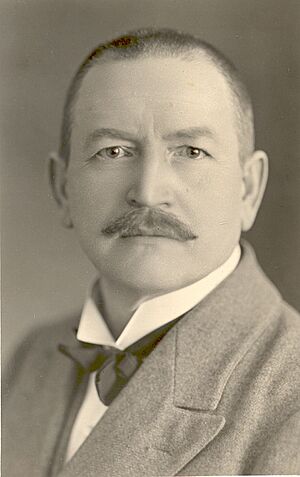Ernst Enno facts for kids
Ernst Enno (born 8 June 1875 in Valguta – died 7 March 1934 in Haapsalu) was an Estonian poet and writer. He is known for his beautiful poems and stories that often reflect his childhood and deep thoughts.
Early Life and Education
Ernst Enno was born in 1875 at Köödsa inn. His father, Prits Enno, was a coachman for the Valguta Manor. Ernst spent his early years on a farm called Soosaar in Valguta, near Rõngu. This time on the farm, along with stories from his religious mother, Ann Enno, and his blind grandmother, greatly influenced his later writing.
When he was eight years old, he started school at Lapetukme. Later, he attended well-known schools in Tartu, including the Hugo Treffner Gymnasium. From 1896 to 1904, he studied business administration at the Riga Polytechnic Institute.
Career and Family
While studying in Riga, Ernst Enno also worked as a journalist. After finishing his studies, he held various jobs. He worked briefly at a credit union in Valga and for a trading company in Pärnu.
He was an editor for the newspaper Postimees in Tartu from 1902 to 1904. Later, from 1923 to 1925, he became the editor of Laste Rõõm, a popular Estonian children's magazine. He also worked on other magazines. From 1920 until his death in 1934, he was a training officer in Lääne County.
In 1909, Ernst Enno married Elfriede Olga Saul, who was an artist.
Literary Work
Ernst Enno's writing was deeply influenced by different ideas and beliefs. These included Buddhism and a way of thinking known as Western mysticism. He also used a style called symbolism in his work, where objects or ideas represent something else.
His childhood spent in the countryside was very important for his literary creations. The stories told by his devout mother and his blind grandmother had a strong impact on him. In his poetry, you will often find recurring themes such as 'home,' 'the road,' and 'longing' (a strong desire for something).
Published Works
Here are some of Ernst Enno's published works:
- Uued luuletused (a collection of poems, 1909)
- Hallid laulud (a collection of poems, 1910)
- Minu sõbrad (1910)
- Kadunud kodu (1920)
- Valge öö (a collection of poems, 1920)
- Valitud värsid (an anthology of his poems, 1937)
- Üks rohutirts läks kõndima (a children's book, 1957), put together by Ellen Niit
- Väike luuleraamat (poetry, 1964)
- Rändaja õhtulaul (1998), put together by Urmas Tõnisson
- Laps ja tuul (2000)


